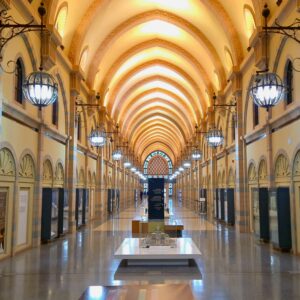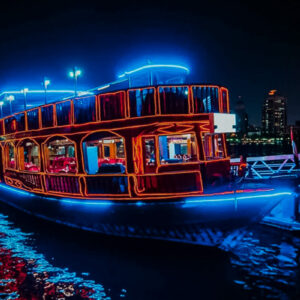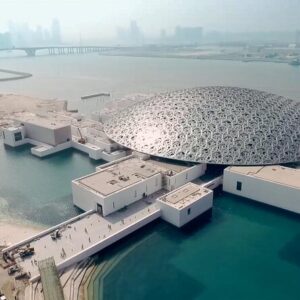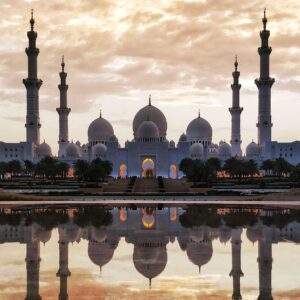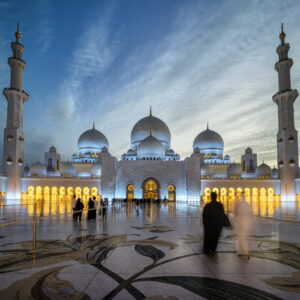Abu Dhabi
The city of Abu Dhabi serves as the federal capital of the UAE.
The city of Abu Dhabi serves as the federal capital of the UAE.
Abu Dhabi, the largest emirate in the United Arab Emirates, covers 84 percent of the country’s landmass. With its 200 islands and a coastline that stretches 700km, it boasts a total area of 67,340 sq. km.
In terms of population, the emirate had an estimated population of 2,908,173 in mid-2016, with 1,857,618 males and 1,050,555 females. Among them, 551,535 were UAE nationals and 2,356,638 were expatriates. The average annual population growth rate from 2010 to 2016 was 5.6 percent.
Geographically, Abu Dhabi lies on the coast of the Arabian Gulf and shares borders with the Sultanate of Oman to the east, the Kingdom of Saudi Arabia to the south and west, and the emirate of Dubai to the northeast. The emirate is divided into three main regions: Abu Dhabi city, Al Ain in the east, and Al Dhafrah (formerly known as Al Gharbia) in the west. Jebel Hafeet, located to the south of Al Ain city, is the highest peak in the emirate, standing at 1,240 meters.
Al Dhafrah comprises seven main cities: Liwa, Madinat Zayed, Ghayathi, Ruwais, Mirfa, Sila, and Delma Island.
Abu Dhabi city is connected to the mainland through four bridges: Maqta bridge, Mussafah bridge, Sheikh Zayed bridge, and Sheikh Khalifa bridge.
When it comes to the economy, Abu Dhabi’s main industry used to be pearl exports before 1958. However, since the discovery of oil, it has become one of the world’s leading energy producers. The emirate currently produces approximately 3.5 million barrels of crude oil and 10.5 billion cubic feet of natural gas daily.
Abu Dhabi is also at the forefront of the global alternative and renewable energy industry. It is home to the world’s largest solar energy field, Noor Abu Dhabi, and the Arab world’s first nuclear energy plant, Barakah Nuclear Energy Plant. Additionally, it plays a significant role in developing clean energy technology and sustainable urban developments through Abu Dhabi Future Energy Company (Masdar).
Abu Dhabi has set its sights on renewable energy to meet 50% of its power needs by 2030. The emirate is making great strides in the global financial arena through its renowned Abu Dhabi Global Market (ADGM). ADGM houses the largest stock exchange in the UAE, ADX, and a specialized crude oil commodity derivatives exchange at ICE Futures Abu Dhabi. These platforms facilitate the trading of ADNOC’s Murban Abu Dhabi crude oil futures contracts, which play a crucial role in determining global crude oil prices. Additionally, ADGM fosters a vibrant ecosystem of fintech startups and SMEs.
Furthermore, Abu Dhabi is actively diversifying its economy by implementing various initiatives and policies. These measures aim to create opportunities, foster innovation, and boost the private sector’s contribution to the emirate’s GDP.
Abu Dhabi has become a hub for top-notch sporting events like the Abu Dhabi Golf Championship, the esteemed Abu Dhabi Desert Challenge cross-country rally, and the Formula One Abu Dhabi Grand Prix.
Moreover, the city boasts the world’s highest concentration of premier cultural institutions, including the Sheikh Zayed National Museum, the Guggenheim Abu Dhabi, and Louvre Abu Dhabi.
Abu Dhabi is also blessed with natural wonders. While the emirate’s renowned Liwa oasis in the southern part is known for its vast and stunning sand dunes, the garden city of Al Ain, nestled at the foothills of Jebel Hafeet, is home to numerous heritage sites.
Abu Dhabi, the capital of the United Arab Emirates, is under the leadership of H.H. Sheikh Mohamed bin Zayed Al Nahyan. He has been the President of the UAE since May 14, 2022.
The Al Nahyan family, who rule Abu Dhabi, are descendants of the Al Bu Falah sub-section of the Bani Yas tribe. Originally residing in the Liwa oasis, they settled in Abu Dhabi in 1793 and resided in Qasr Al Hosn for nearly two centuries.
Abu Dhabi operates under an Executive Council, which oversees various departments similar to ministries. Additionally, there are autonomous agencies with clearly defined powers, and a National Consultative Council consisting of representatives from the main tribes, totaling 60 members. The rulers’ representatives oversee the regions of Al Ain, Al Dhafrah, and the oil terminal of Das, while the municipalities govern the main cities of Abu Dhabi and Al Ain. A municipal authority has also been established for the western region.


